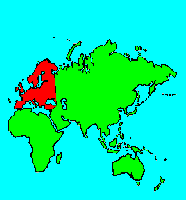SPECIES INFO
Dune gentian (Gentianella uliginosa) is found in Europe. It can be found in Britain, NW Europe, and east into Russia. This annual or biennial is rare, and the populations are declining. This is a low growing plant with multiple stalks. The leaves are oval and pointed. The flowers are on long petioles and can spring from the leaf axils.Gentianella genus is native to Europe, temperate Asia, North and South America, and New Zealand. There are about 125 species of smooth annual, biennial, or perennial herbs in this genus. The paired stem leaves are generally opposite. Some leaves are also often in basal rosettes. There are nine species and nine named subspecies growing in greater North America.
Gentian (Gentianella) genus is frequently combined into the Gentiana genus. In this publication we have followed Kartesz and have treated this group as a separate genus. We have created entries for all of the Kartesz North American species in this genus.
Gentian Family (Gentianaceae) contains mostly non-woody species of worldwide origin. There are about eight hundred species in this family. Many fine United States wildflowers are in this family. In greater North America, this family contains 117 species arranged in 17 genera.
The Gentian family is very widespread in both temperate and tropical areas. The Sahara region of Africa is one of the few areas lacking representation.
Contortae Order is usually organized to contain the Olive, Gentian, Milkweed, and a few other families. Recently some authorities have removed certain genera from the Gentian Family and placed them in the Menyanthes Family.
Dicots (Dicotyledoneae Class) are the predominant group of vascular plants on earth. With the exception of the grasses (Monocots) and the Conifers (Gymnosperms), most of the larger plants that one encounters are Dicots. Dicots are characterized by having a seed with two outer shell coverings.
Some of the more primitive Dicots are the typical hardwood trees (oaks, birches, hickories, etc). The more advanced Dicots include many of the Composite (Aster) Family flowers like the Dandelion, Aster, Thistles, and Sunflowers. Although many Monocots reach a very high degree of specialization, most botanists feel that the Dicots represent the most advanced group of plants.
Seed plants (Phylum Embryophyta) are generally grouped into one large phylum containing three major classes: the Gymnosperms, the Monocots, and the Dicots. (Some scientists separate the Gymnosperms into a separate phylum and refer to the remaining plants as flowering plants or Angiospermae.)
For North American counts of the number of species in each genus and family, the primary reference has been John T. Kartesz, author of A Synonymized Checklist of the Vascular Flora of the United States, Canada, and Greenland (1994). The geographical scope of his lists include, as part of greater North America, Hawaii, Alaska, Greenland, Puerto Rico, and the Virgin Islands.
Kartesz lists 21,757 species of vascular plants comprising the ferns, gymnosperms and flowering plants as being found in greater North America (including Alaska, Hawaii, Greenland, Puerto Rico and the Virgin Islands.
There are estimates within the scientific world that about half of the listed North American seed plants were originally native with the balance being comprised of Eurasian and tropical plants that have become established.
Plant kingdom contains a large variety of different organisms including mosses, ferns, and seed plants. Most plants manufacture their energy from sunlight and water. Identification of many species is difficult in that most individual plants have characteristics that have variables based on soil moisture, soil chemistry, and sunlight.
Because of the difficulty in learning and identifying different plant groups, specialists have emerged that study only a limited group of plants. These specialists revise the taxonomy and give us detailed descriptions and ranges of the various species. Their results are published in technical journals and written with highly specialized words that apply to a specific group.
On the other hand, there are the nature publishers. These people and companies undertake the challenging task of trying to provide easy to use pictures and descriptions to identify those species.

